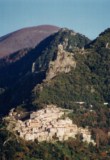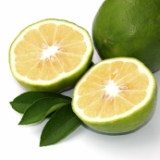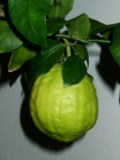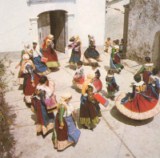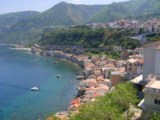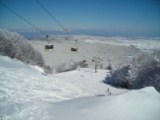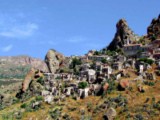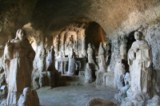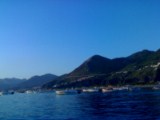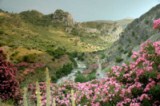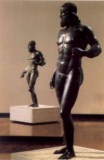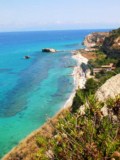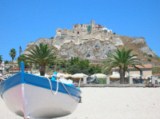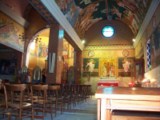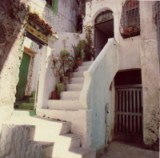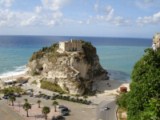|
HOTEL ROOMS ACCOMMODATIONS OFFERS IN CALABRIA
STAY BY GEOGRAPHICAL DESTINATION IN COASTAL MOUNTAIN OR RURAL AREA
La Sila
Riviera dei Cedri
Pollino National Park
Aspromonte National Park
Raganello River
The "Bergamotto"
Wine & Food
Climate
Calabria makes up the "toe"of Italy
and is an area little known to British visitors. Ideal for a relaxed
stay in one of it's splendid locations and as starting point for
excursions in wonderful sceneries of Southern Italy only few
hours away like Amalfi coast, Sorrento, Capri, Sicily, Agrigento, Taormina
and Apulia. This is a land with a wonderful coast line; dramatic
cliffs overhanging secluded bays; steep cliff paths to small rocky coves;
islands and caves to explore; long stretches of beach, gently curving
into the distance all are lapped by the clear, azure sea.
The scenery is spectacular and dramatic, rising to over 6000 ft in the mountains,
and dropping steeply to the coast with its long stretches of beach,
crescent-shaped bays, craggy cliffs and islands dotted about in the
crystal clear, blue, Tyrrhenian and Ionian seas.
One wonders how so much variety of landscapes can be captured within
one region. You will be amazed at the beauty of the tree-covered mountains,
with their leash green valleys and their summits capped by little towns,
which seem to perch precariously or else be sculpted into the rock.
The winding roads, which climb through the mountains, reveal, at every
corner, breath-taking views of the valleys far below and the sea sparkling in the distance.
You will be spoilt for choice whether in the mountains or on the coast,
there is more to see and explore than can possibly be done in a couple
of weeks. On the other hand, the slow southern Italian pace of life
is perfect for just relaxing.
Calabria is steeped in history, myth and legend. There are prehistoric settlements
and early cave dwellings. The region features in the writings of Homer
and Virgil and has been fought over by Hannibal, Romans, Sparticans
and many others, so that there is evidence of numerous different
civilizations, medieval towns and villages, castles and towers.
Even in the small hill top towns, you can stumble across fine examples of Byzantine and Norman architecture.
It is also rich in living tradition and folklore. Throughout the year,
there is a wealth of festivals and carnivals, involving much music and
dancing, often in traditional costume. These are not "contrived for
tourists" but are long-lived traditions, which have been passed on through
the generations, and are still strong today.
Climate

The morphological structure, the flora and fauna for Calabria are indirect
evidence of how this region enjoys a varied climate, characterized,
despite the long narrow conformation, by longitudinal, not latitudinal
zones. Three types of climate can be found: Tyrrhenian, mountain climate,
and Ionian.
The climate of the first zone is hot but temperate in summer, mild in
winter, with a moderate rainfall which, however, comes in sudden downpours.
The mountain zone has a more alpine climate and the peaks are snow-covered
during the winter, thus allowing winter sports there. These peaks are,
in summer, a welcome refuge for those who seek relief from the heat.
The Ionian zone is the hottest and the favourite of sunbathers. The
sky is rarely cloudy, since the annual level of rainfall fluctuates
between 800 and 600 millimetres, 1,000 millimetres less than in the
mountain zone. In the space of only a hundred kilometres, the visitor
passes from one environment to another completely different, another
reason for the great attraction which Calabria has for many people.
Calabrian Cooking
Other Regional Info

Calabrian
cooking has become immensely popular. In the past few years, connoisseurs
such as Veronelli and Carnacina have often included Calabrian recipes
in their references to Italian gastronomy. In addition a lot of indirect
publicity has been provided on an international scale by dietologists
who, with the Americans to the fore, have discovered that Mediterranean
cooking and particularly Calabrian, is one of the healthiest. Olive
oil is now seen as highly nutritious, good for the arteries and withstanding
change at high temperatures. The small red chilli pepper turns out to
be a vasodilator and whole meal bread fibre is good for the digestive
system.
Calabrian cooking is healthy in fact, because it is simple and plain. Nevertheless,
imagination and necessity in people often isolated for long periods
have supplemented this simplicity with inventiveness in food preparation.
Numerous historical references attributing noble origins as well to
Calabrian dishes are found in Greek and Latin literature, preserved
for us by 16th century scholars, such as Girolamo Marafioti.
The delicate fish recipes of Sybaris for example, were renowned throughout
the classical world. Admittedly, the most original Calabrian recipes
call for lengthy preparation and a lot of work, and the housewife may
have to start cooking at dawn, often using methodical ways. For this
reason, apart from the many characteristic restaurants, rural traditional
cooking is found mostly in the inland villages, where few of the women
go out to work. The "fusilli di casa" is common; this home made pasta
is rolled around bits of wire or sticks (in Greek Calabria, where called
cannici).
At Vibo Valentia, this pasta is known as "fileia". It is always served
with a meat sauce, made of well-cooked pork, often mixed with veal and
goat meat (in the Greek area, Bova). Another popular dish is vegetable
soup, or pasta and vegetable soup, e.g. pasta and beans, pasta and broccoli,
pasta and broad beans, polenta and cabbage, rice and endive, pasta and
courgettes, pasta and artichokes, pasta and peas.
The main ingredient of each dish is olive oil, never lacking in the Calabrian
larder, together with home made tomato sauce, aubergines and salami.
The so called small meats, lamb, kid and goat, are renowned, and a well-known
dish is "Capra alla bovese" (Vutana): goat meat boiled with herbs is
popular, as is char grilled kid, eaten throughout the entire region.
Pork is an important ingredient, and a popular dish is the "frittula",
hot pig's skin eaten with warm bread. Butchers' shops in Reggio Calabria
still keep a hot pan near the door, in which the tastiest morsels of
pork are cooked in their own fat. Catanzaro is well known for its "murzeddu
or morsello", its own specialty, made of tripe, cow's heart and lungs,
well seasoned with herbs and spices and served in a "pitta", a round
roll of flat home baked bread.
An interesting white meat dish at Altomonte, is roast cockerel; a classical
fish dish is sword- fish caught with fishing nets in spring off the
Violet Coast between Villa San Giovanni and Palmi. Traditionally, it
is grilled in an herb, olive oil and vinegar sauce or served "alla marinara"
with tomato and parsley. Traditional to Calabria is "baccala "
spugnato",soaked salted codfish which In some
areas acquires a particular flavor, probably from the water. "Baccala'"
can be cooked in many ways, but traditionally it is fried in batter
or baked "alla molinara" with fresh tomatoes and potatoes. In the Crotone
area, "sardella salata", small blue fish salted and seasoned with powdered
red chilli peppers and olive oil and eaten spread on bread as an appetizer.
Aubergines are one of the basic ingredients of Calabrian cooking, and
are extensively used. Every part of this amazing vegetable is used,
including the skin, with excellent results. Often the aubergines is
served as a main course such as "melanzane alla parmiggiana" baked with
Olive oil, tomato sauce and Parmesan cheese. But many other recipes
include aubergines, like "melanzane ripiene" (stuffed), "caponata" (fried aubergines, peppers, fresh tomatoes and onions), roasted, skinned and
seasoned with olive oil and garlic, and grilled with olive oil, garlic
and parsley.
WHERE TO EAT - WHERE TO HAVE FUN - SPONSORS |
| |
|
| |
|
YOUR ADVERTISEMENT BANNER HERE |
Cakes

There is also a vast assortment of cakes and perhaps more than any other
aspect of Calabrian cookery, sweet things are most intimately linked
with genuine local tradition, especially at Christmas and Easter. This
probably arises from the fact that, in a relatively poor economy, sweets
and cakes are considered luxuries to be enjoyed only on great occasions.
In almost the whole region at Easter, the "sgute" or "aggute" or "cuddhuraci"or
"cuzzupe", cakes are made, in the shape of a handbag with a handle.
One or more hardboiled eggs are inserted in the pastry and the top is decorated
with symbols. another traditional cake is the "nacatula", once eaten
at weddings, and also at Carnival time, fried in olive oil. The "mostacciolo",
made of flour, fig honey and almonds, is another genuinely traditional
Calabrian cake, found all over the region, but of great importance,
for the local economy, at Soriano Calabro, in the Catanzaro serre. "Mostacciolo"
or "nzuddo"can still be bought at any fair and in displayed in the characteristic
"mustazzolari" chests. It is made in all shapes and is often a veritable
haut relief, trimmed with tinfoil, and is still sometimes given in inland
towns as a symbolic engagement or wedding present.
The figures on it often recall pagan motives (babbaluti)or early Christian
fish and bird symbols.
"Petrali"are made of fruit and belong to the tradition of
the Greek areas of Calabria, though they are made with variations by
Reggio di Calabria confectioners. Another typical cake is the "pignolata",
made of small balls of sweet pastry fried in olive oil and stuck together
with honey, found in most of the region.
Torrone (nougat) is made at home but also industrially, and is thus
of economic importance. Traditionally a Christmas sweet, it is made
of honey, sugar, almonds and chocolate. Another Christmas cake is the
"pitta di San Martino", made of candied fruit (the polistena "pitta"
is particularly good).
Cheese

As far as cheese is concerned, mention must be made of the delicious
Sila and Pollino cheeses, particularly caciocavallo, a soft, fairly
strong provola, and "butirro", provolone with a butter centre. Excellent
is the cow's milk cheese made in very small quantities by the monks
of the San Bruno monastery, at Serra San Bruno, like the goat's milk
cheeses from Aspromonte, made at Bova, Roccaforte del Greco, Staiti,
Motta San Giovanni and Roghudi, Connoisseurs consider the Calabrian
goat's milk cheeses as some of the best.
Wines

Calabria has a vast range of wines, and each part of the countryside seems to
have its own. Much appreciated by the ancient Greeks and Romans, Virgil
and Pliny sing the praises of the fruit of the vine, and it is certain
that in antiquity, Calabria was the land of wines (hence the name
Enotria), and over a hundred varieties of vine were known there at the
time of the Greeks.
Generally speaking, Calabrian red wines are better than the white, andsuch is their
strength and body that they are widely used to "cut" a large number
of Italian wines, including the renowned Barolo, as well as foreign.
The controlled origin wines (DOC) in Calabria are now Cirņ,
Melissa, Lametia, Savuto(along the Savuto river), Donnici,
(upper Crati valley, Cosenza province),
Grecodi Gerace (a white wine, Gerace area) and Sant'Anna (isola di Capo Rizzuto).
Apart from these wines, of which the world famous Ciro' is outstanding and
described as the oldest wine on earth, many others deserve a mention,
and though well known, have not been accorded the DOC recognition. These include
Pellaro, originating a few miles south of Reggio di Calabria, known
for its robust quality, flavor and strength (14-16°); Kalipea, made
at Locri, golden in color; Limbadi (Vibo Valentia), a good table wine;
Rossano, made in the area near the town, ruby colored with a high alcoholic
content; Verbicaro (Cosenza), from the Lao river basin. A curiosity
is the Trasfigurato wine from Seminara, kept in terracotta containers
and smoked, There are hundreds of other wines, all good, and the search
for Calabrian wines can be a fascinating pastime for visitors wishing
to get to know Calabria, not only for what it is but for what it has
to offer.
The "Bergamotto"

On the coast plains of Calabria, in the small villages and towns,
you can find "aracicarias" and "eucalyptus"
trees, that easily grow here thanks to the favourable climate as well as vast palm groves and robust ficus trees, that give the fruit known as "Indian figs" as well
as the more usual figs.
Calabria and it's Mediterranean climate allow the growth of the "Bergamotto".
This rare tree needs certain climate and soil conditions in fact it
only grows in Calabria throughout the whole planet. It is not used
for food purposes but for the oil that it gives when squeezing the
external part of the fruit, known as the "essence of bergamot".
This essence has a fresh and delicate perfume and is main ingredient
for eau de cologne. It is exported all over the world to major perfume
companies and hopefully will last for quite a while, but it's presence
on the perfume market solely depends on the will of the companies
to keep a natural product as essence for perfumes or to replace it
with a chemical product.
|



